PROTECT YOUR DNA WITH QUANTUM TECHNOLOGY
Orgo-Life the new way to the future Advertising by AdpathwayA healthy, full rose with an attractive shape needs little, if any, pruning in late summer. Others benefit from a light trim now for a refresh after an active season of growing and flowering, especially if we hope to get a fall flush.
While we reserve heavier pruning and shaping for late winter, or right after summer flowering for single-season bloomers, pruning roses now gives us time to improve their health and to tidy up shrubs and climbers before they prepare to overwinter.
Late summer is prime for removing crossing, diseased, or dying branches to nip any dieback problems in the bud (so to speak). A final round of deadheading for repeat-flowering beauties spurs late-season flowers and showy rosehips that persist into winter.
Rose pruning varies by type of rose and climate. From climbers to rambliers, old garden roses to hybrid teas and grandifloras, timing differs according to when they flower and set buds. It also depends on the length of the growing season and the first and last frost dates. Pruning roses this time of year takes less precision, as it’s a time for preventative measures and fostering blooms rather than drastic cuts.
While we’re tending the roses, it’s also a good time to think about adding to the collection. Fall is ideal for planting roses or transplanting those in need of a new garden location.
If you’re ready to prune roses now, follow these steps to get it right.
Peggy Martin Climbing Rose

Peggy Martin Climbing Rose
The Champion Sunblush Rose

The Champion™ Sunblush Rose
Cinnamon Hearts Rose


Late Summer Rose Pruning
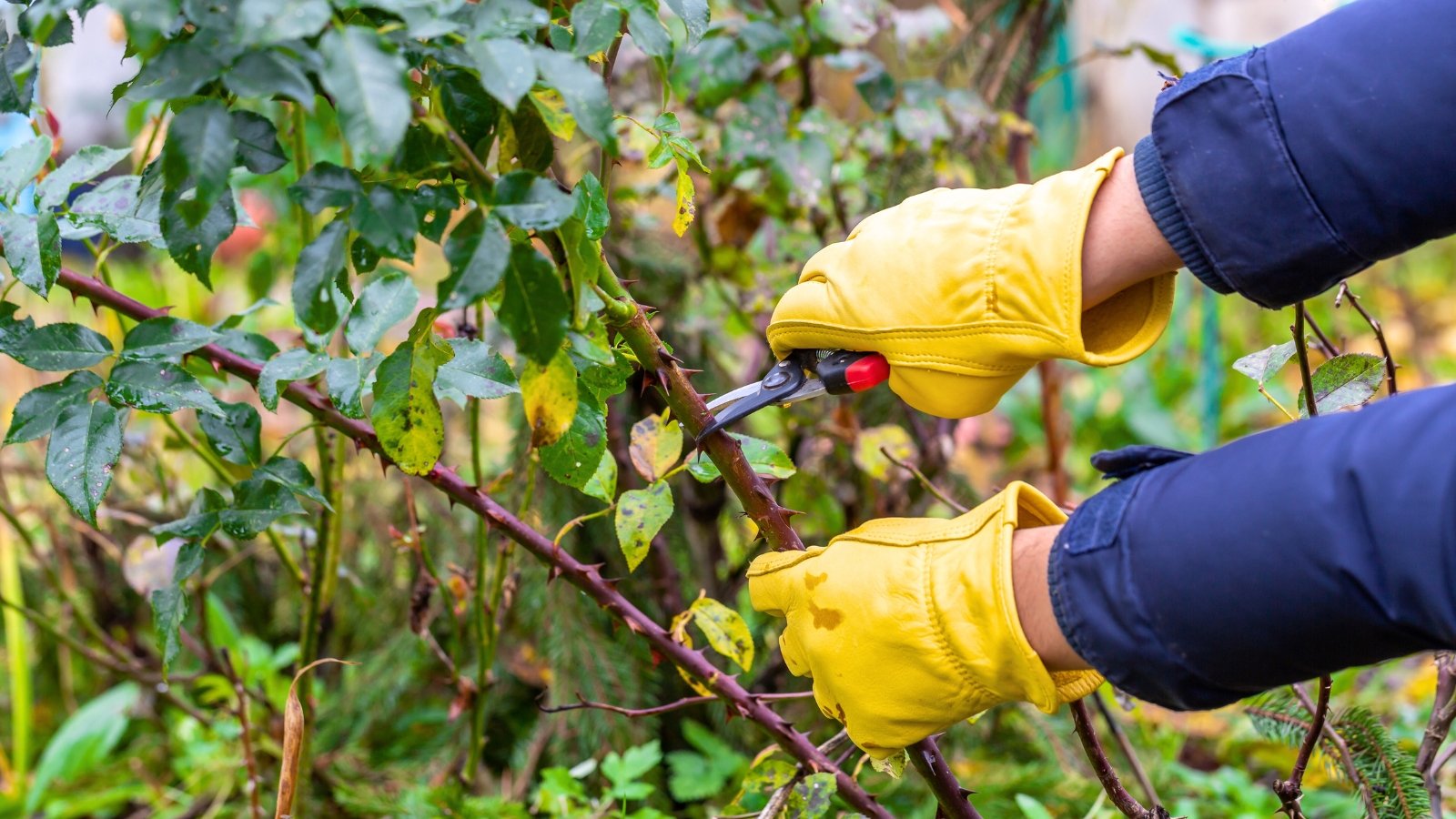 Avoiding heavy cuts helps plants store energy efficiently.
Avoiding heavy cuts helps plants store energy efficiently.With any light trims and rose pruning now, you’ll want to stop four to six weeks before the first frost date to prevent winter damage to tender new stems.
That’s why we avoid heavy pruning now. It promotes new growth that’s susceptible to cold damage and also draws energy that should go into roots and stems for overwintering (rather than into active growth).
Pruning roses now:
- Improves form for a fall display
- Prevents disease spread and overwintering
- Halts die back
- Increases air circulation around leaves and stems
- Boosts flowering for reblooming types
- Promotes strong canes for climbers, ramblers, and shrubs
The Right Tools
 Sharp tools make clean cuts, preventing plant stress.
Sharp tools make clean cuts, preventing plant stress.Bypass pruners are best for most cuts like deadheading, harvesting roses, and cutting back thin stems. Long-handled loppers make easy work of woody or hard-to-reach canes.
When it comes to roses (and any plant), two tool practices come in handy for healthy pruning: sharp blades and sanitization. Sharp tool blades are essential for making clean cuts. Dull blades can shred or tear stem tissues and create wounded entry points for pests and diseases.
Sterile tools help minimize common rose diseases that spread easily. Spores and pathogens travel on tools between plants. A simple alcohol wipe on the blades does the trick. A dip or spray of rubbing alcohol (70% or higher concentration of isopropyl alcohol) also does the trick.
The Right Cut
 Cutting above a leaf node encourages new growth.
Cutting above a leaf node encourages new growth.When you prune roses now, look to cut above a leaf node or outer bud. Travel down the stem from the bloom to a healthy set of leaves. Cut the stem to your desired length (long for single-stemmed cut flowers, or shorter for clustered blooms).
The flowering shrubs can take light shaping this time of year, with that six-week buffer before frost, especially in warm climates. Aim for a rounded shape when deadheading, harvesting for fresh arrangements, or tidying up.
Clip stems and canes above an outer bud or leaf node (where leaflets meet the stem). Make a straight cut or angle the cut downward toward the center of the plant.
The pass-along knowledge is that cutting stems on a 45-degree angle helps water run off the surface rather than collect on the stem and bud to cause potential diseases. While there’s no proven advantage, either clean cut will work. The main point is to cut near a node where new growth will emerge.
Deadhead
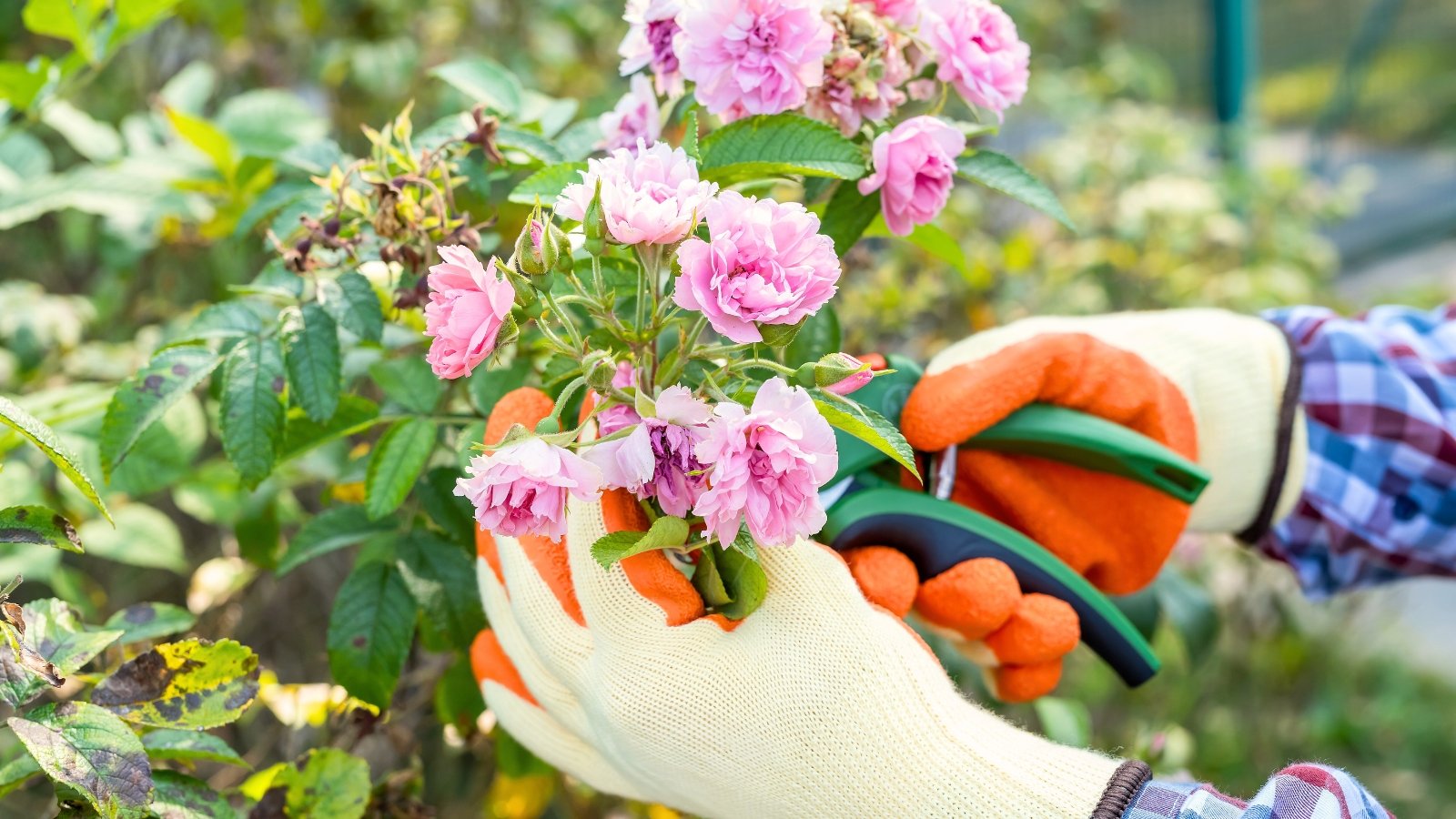 Removing drooping flowers encourages vibrant seasonal growth quickly.
Removing drooping flowers encourages vibrant seasonal growth quickly.Deadheading works across rose types and is a good practice when you prune roses now for free-flowering types. It helps minimize damp conditions that harbor fungal spores, tidies up the plant, and promotes that fall flush of blooms.
The faster we deadhead reblooming roses, the quicker they’ll reflower. Clip away fading flowers when they begin to lose their color. Petals will droop, wither, turn brown, and drop.
Whether removing a single long-stemmed bloom or an entire aged cluster, cut down the stem above a leaf node. It’s preferable to clip where five leaflets meet the main stem (as opposed to smaller leaves). You may reach three leaflets first, but five indicate stronger, thicker stems.
If you’re deadheading one of those oddly long shoots that jetted up to flower, cut the stem down to size to meet the rest of the shrub. This still isn’t heavy pruning, which should wait until fall or early spring.
When to Stop
 Ending deadheading gives colorful fruits time to mature.
Ending deadheading gives colorful fruits time to mature.Stop deadheading repeat-flowering roses in late summer, six to eight weeks before the anticipated frost date, as the ornamentals prepare for winter dormancy. The active growing cycle naturally slows, and they need to redirect energy rather than continue to produce new growth and blooms.
Wrapping up deadheading in August and September gives hip-bearing roses time to set fruit for the cool season. Some roses don’t develop showy hips, but others produce fruits in red, orange, yellow, and purple.
Rose hips extend seasonal interest well into fall and even winter. Songbirds and wildlife forage on the fruits as a cool-season food source.
Remove Crossing, Diseased, and Declining Canes
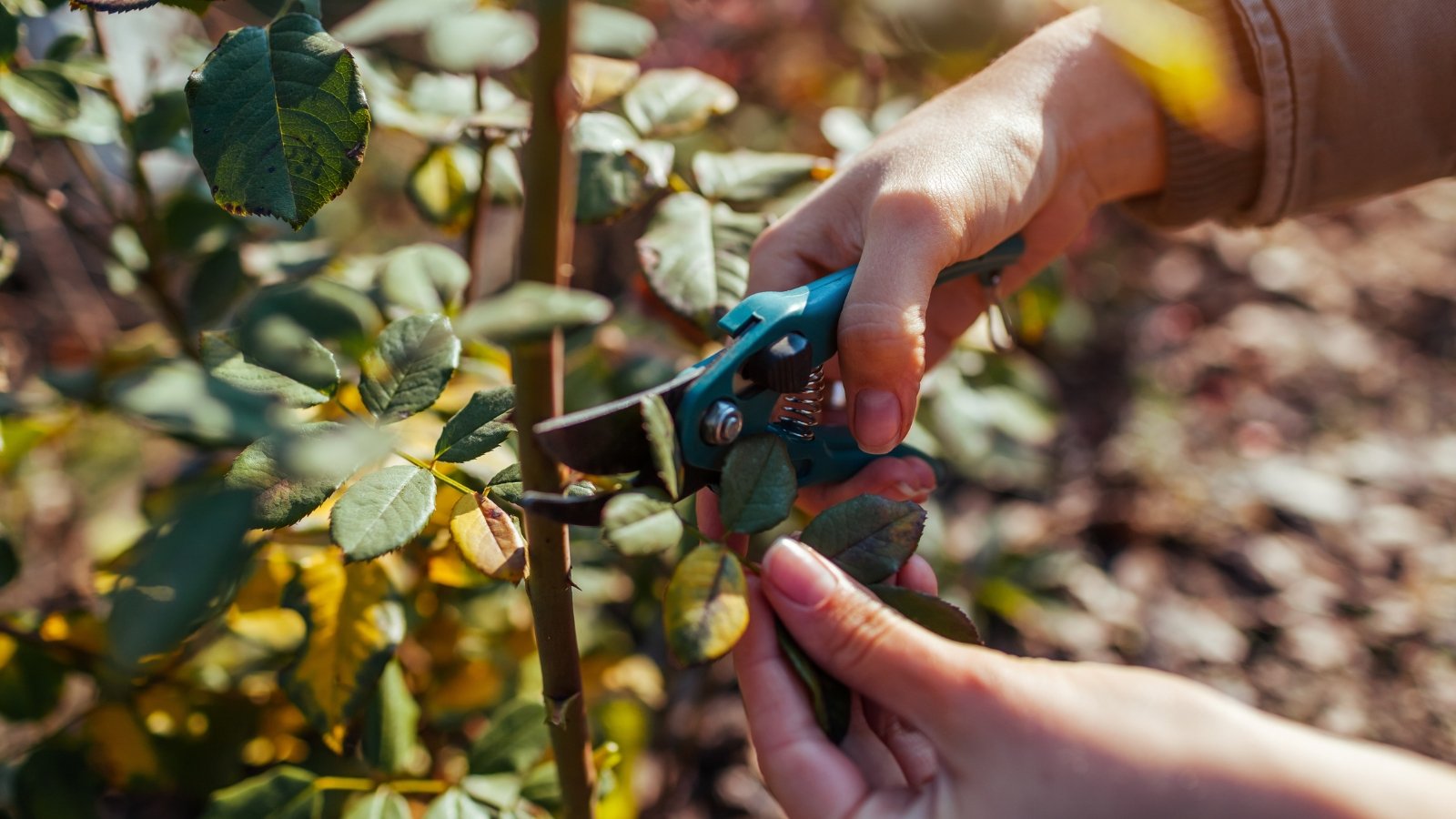 Clear out crossing stems to prevent damage naturally.
Clear out crossing stems to prevent damage naturally.A good practice any time of year, prune roses now to cut away diseased, dead, and declining canes for overall health. Freeing the interiors of dying canes limits disease, improves air circulation, promotes good form, and directs energy to the most vigorous stems.
Cut out crossing stems, as their rubbing injures healthy tissues and exposes them to cold damage and disease issues. To prune declining or dead canes, cut them back to the first section of healthy, green growth. Dead canes are brown and brittle, while healthy stems are green or white and pithy.
Look for Dieback
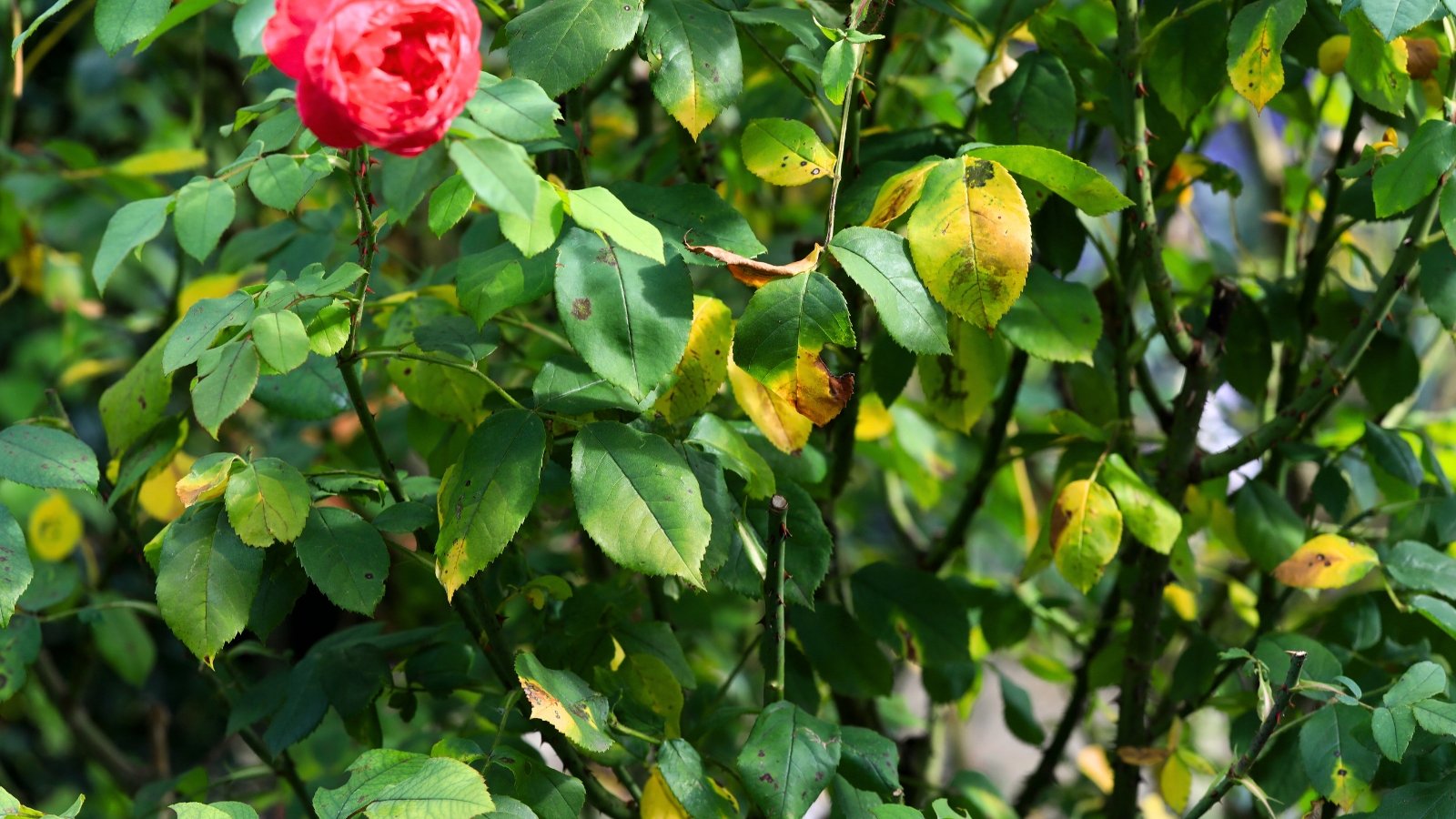 Dieback shows that stems cannot feed their leaves.
Dieback shows that stems cannot feed their leaves.Dieback is a common symptom among the flowering shrubs that can crop up at any time. In late summer, dieback may show from earlier pruning missteps or cultural fluctuations like weather extremes.
Dieback is a sign of an underlying issue. A stem begins to die from the tip and works its way down. Tissues become unable to uptake moisture and nutrients to the leaves, which turn yellow and drop. The stems turn black as the condition spreads.
To halt the spread, prune roses now to remove the affected portion. Cut to a healthy part of green stem with white interior tissue, just above a leaf node.
Cut Weak, Spindly Shoots
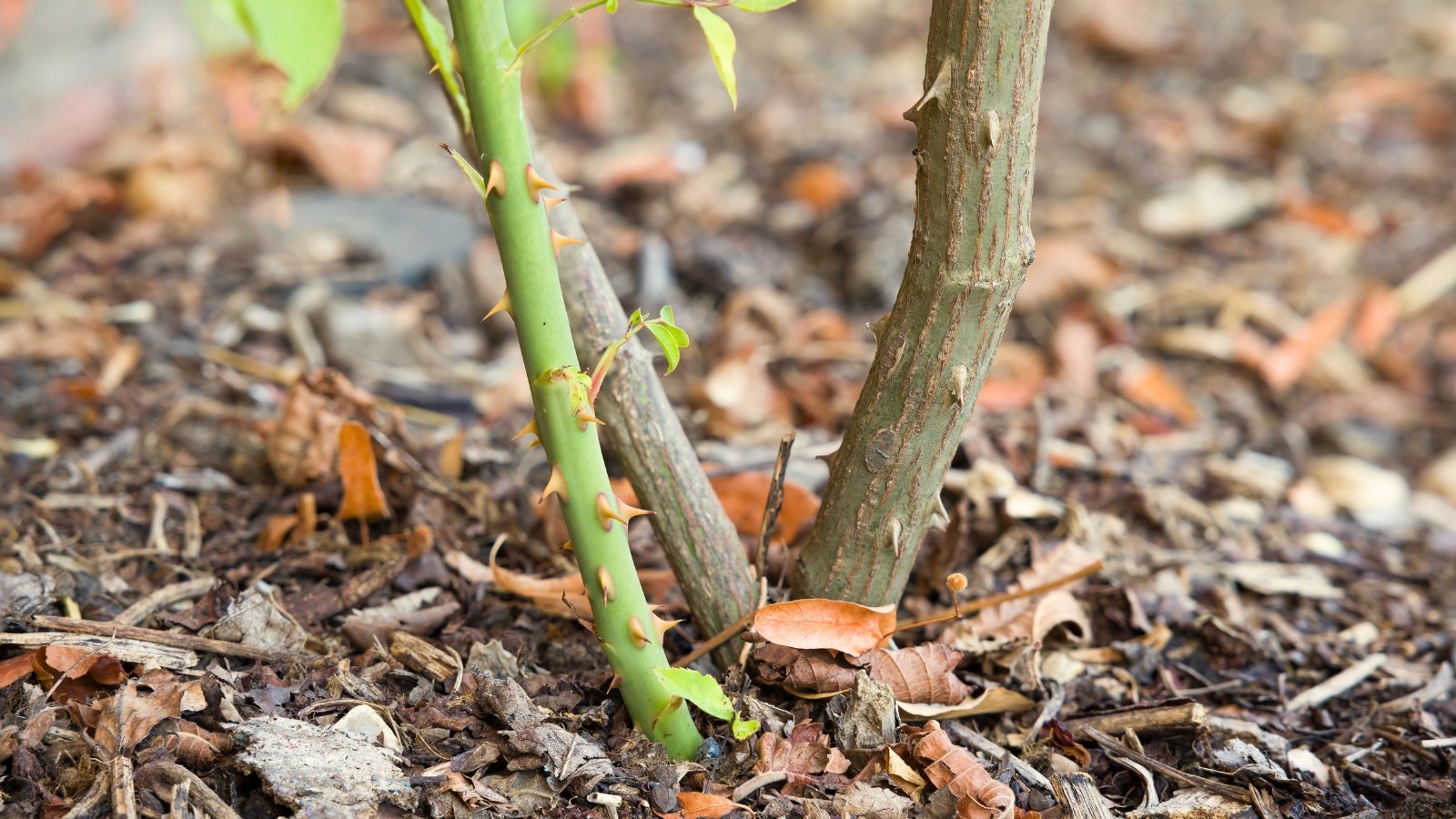 Snip suckers at the base to save vital nutrients.
Snip suckers at the base to save vital nutrients.Cutting out weak, spindly stems and suckering offshoots now opens the interior for increased airflow and fosters the most vigorous stems.
Suckers are the fast-growing shoots separate from the primary horizontal canes. They may crop up from the original rootstock of a grafted rose. Cut them at the base to minimize reversion. They also absorb moisture and nutrients from the roots that would better serve the primary canes.
Prune lateral sideshoots from climbing and rambling roses now to increase interior airflow and detangle primary canes. Remove long, whippy stems too that may receive winter damage with wind and cold exposure.
Trim Reblooming Roses
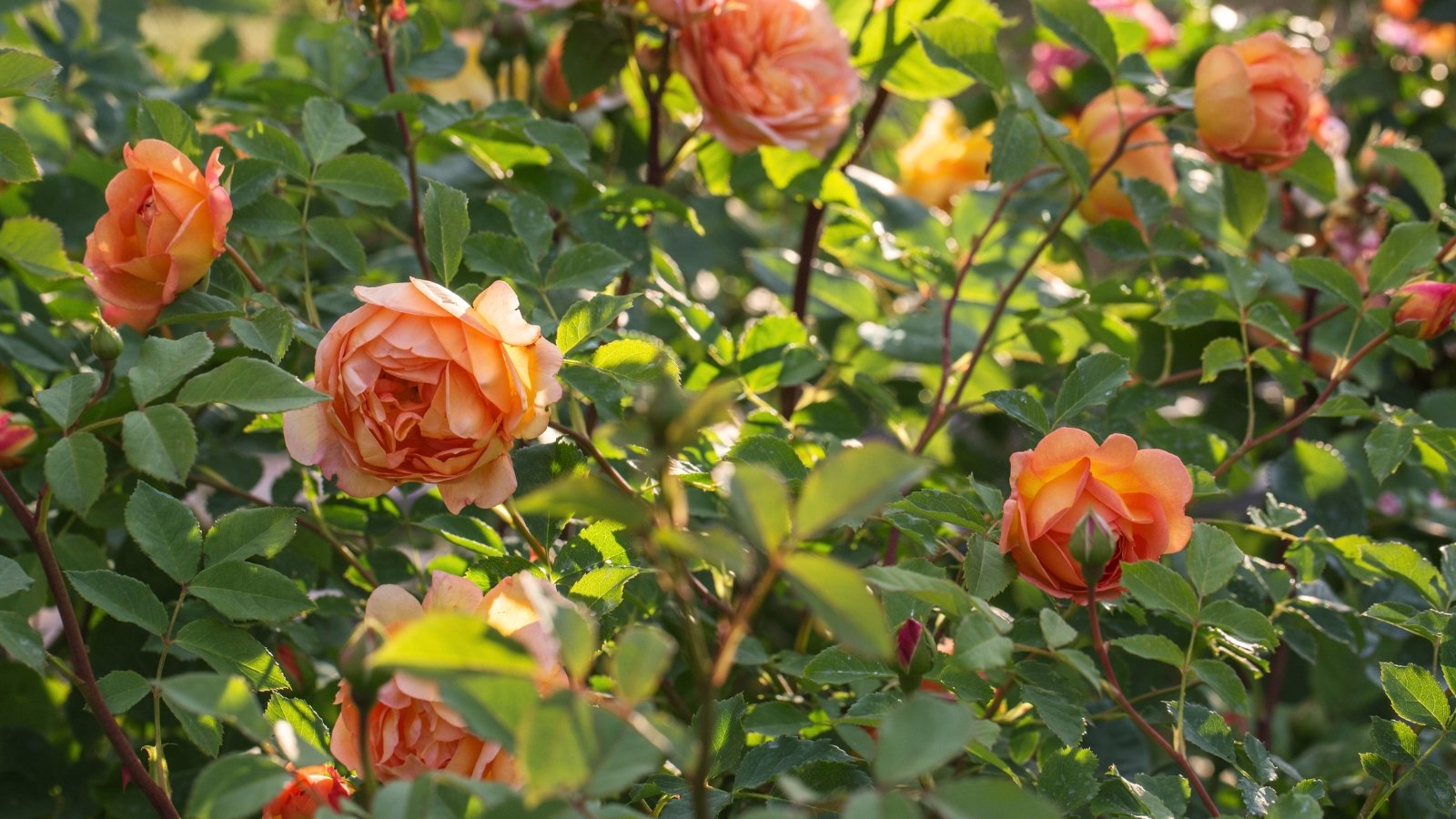 Tidying fading blooms encourages an October floral show.
Tidying fading blooms encourages an October floral show.I’ve mentioned reblooming roses and the effect of deadheading now to encourage a late-season flush of flowers. In warm climates, prune these roses now to encourage new growth and buds. With less existing growth to support, fresh growth emerges with time to harden off before frost (or for continued growing in frost-free climates).
A trim in August means an October show. Do light shaping with your regular round of deadheading. It may mean clipping the remaining summer blooms, so plan to bring the bouquet indoors with any fresh stems.
Remove Debris
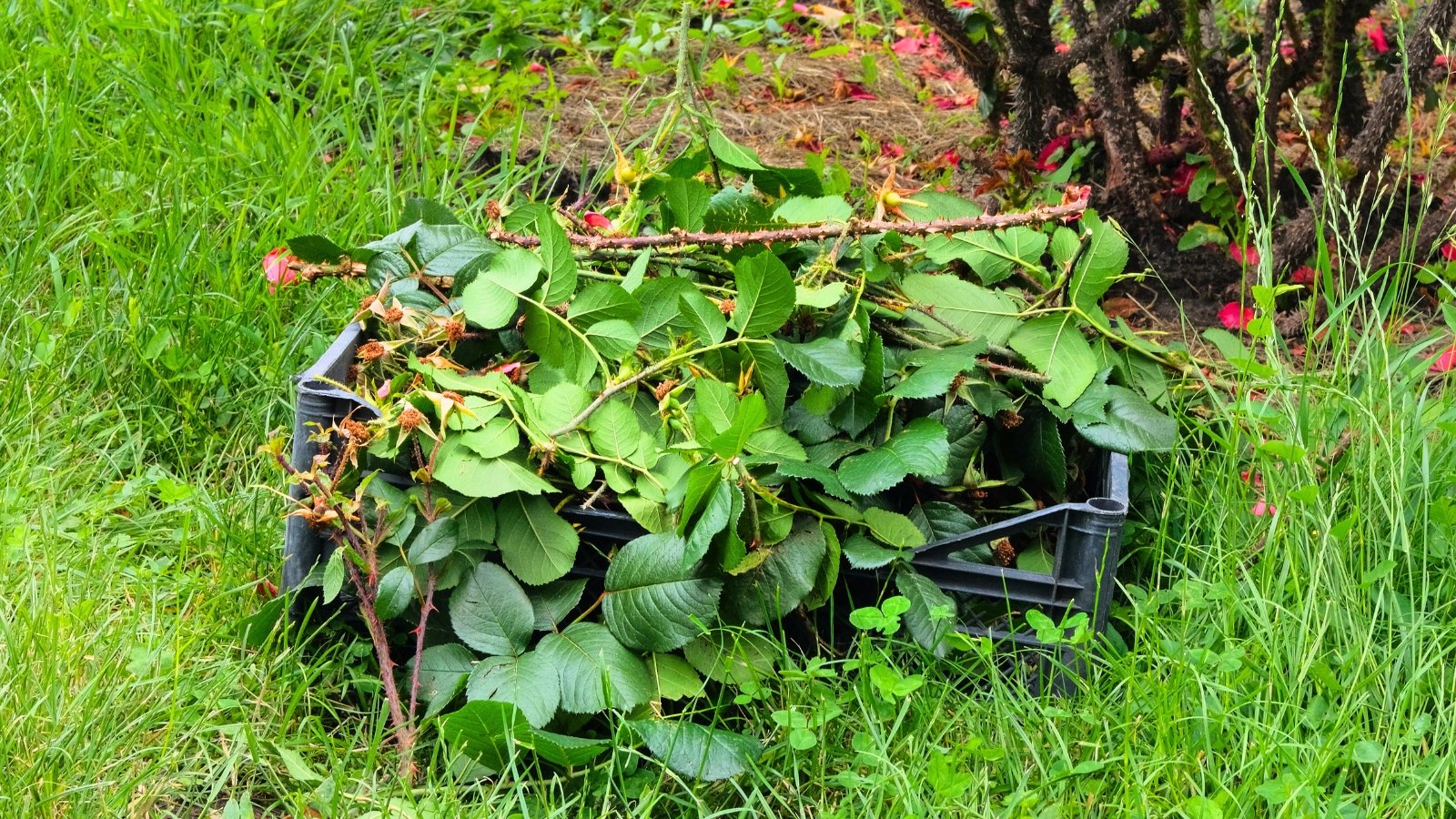 Clearing dead leaves limits infections during the cool season.
Clearing dead leaves limits infections during the cool season.The final step when you prune roses now is to discard the debris. Since roses transmit diseases easily, bag up the clippings to throw away, or plan to burn them. Skip the compost pile, where fungal, bacterial, and viral pathogens can overwinter and spread to other plants.
For the best health, clean the bed of dropped leaves and petals. The end-of-season spruce-up tidies the area and limits potential diseases.
Don’t Forget Watering, Fertilizing, and Mulching
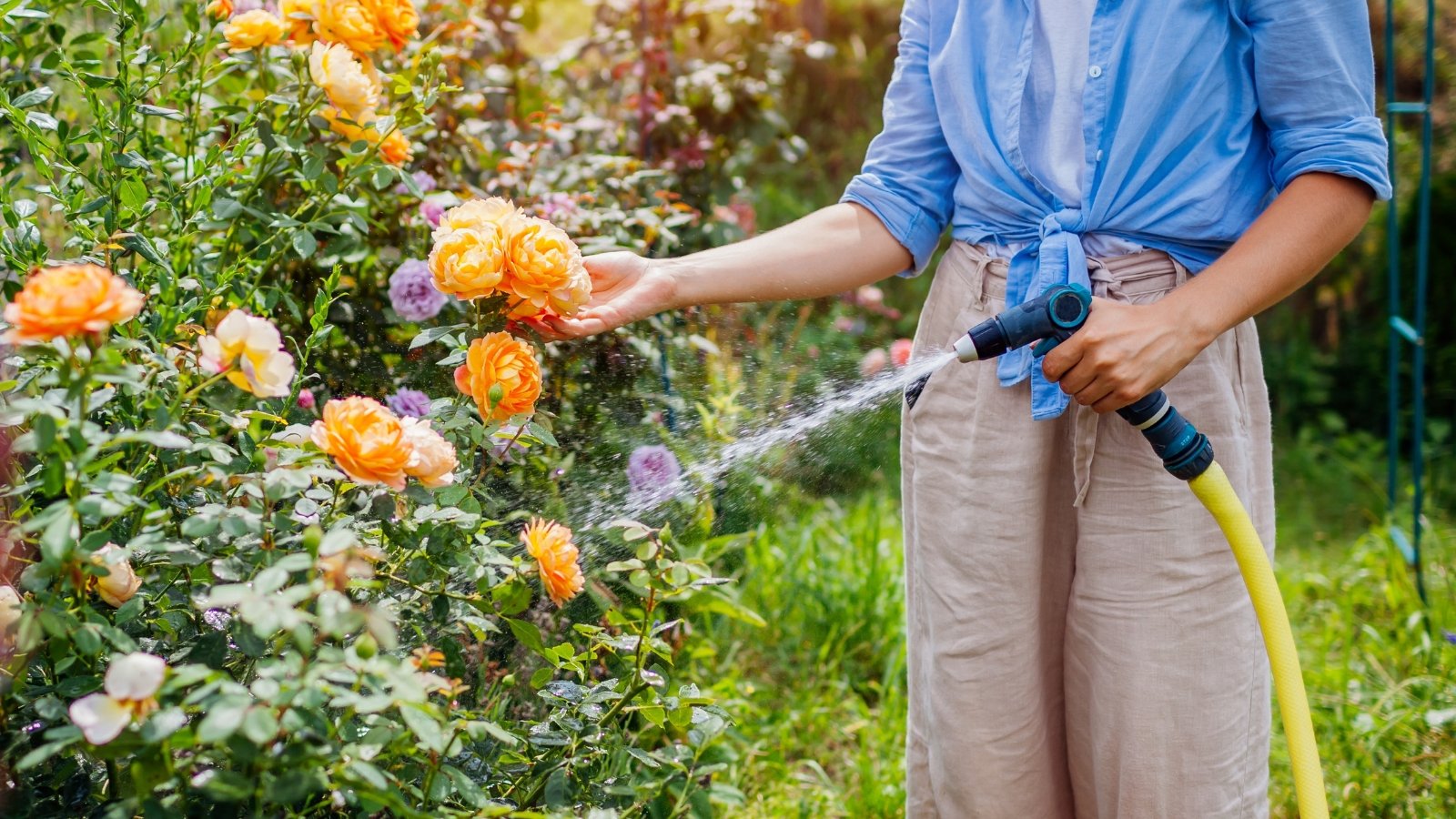 Water thoroughly during dry, windy, or hot periods.
Water thoroughly during dry, windy, or hot periods.While it’s important to prune roses now, end-of-season maintenance still includes watering through frost and providing an adequate mulch layer.
Late summer can be a time of high heat and fluctuating conditions, including rainfall. With ample rain, roses don’t need supplemental watering. Reduce or stop watering sessions during rainy weeks. Add a session or two of deep weekly watering during dry spells, windy conditions, and intense heat.
August marks the last month to fertilize reblooming roses to support a late-season display. Opt for a specialized rose fertilizer with phosphorus. Foliar feeds, too, promote a fall flush of flowers for repeat-flowering varieties. Stop fertilizing at the same time pruning stops, about six to eight weeks before frost.
A three-inch layer of mulch year-round helps regulate soil temperatures and retains moisture. It cools roots in the summer and insulates them in the winter. Mulch also helps prevent water and fungal spores from splashing up from the soil.


 8 hours ago
2
8 hours ago
2


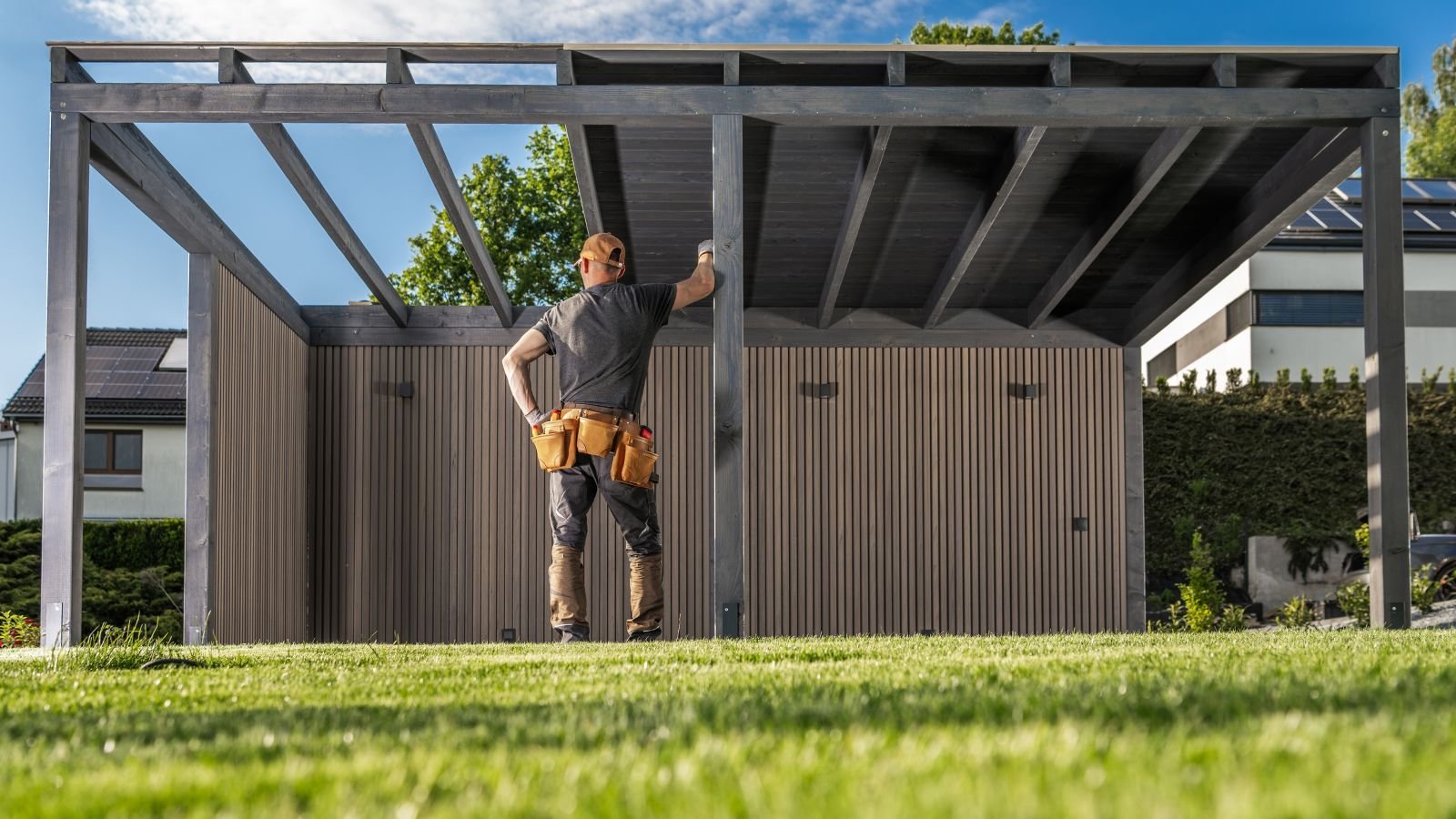
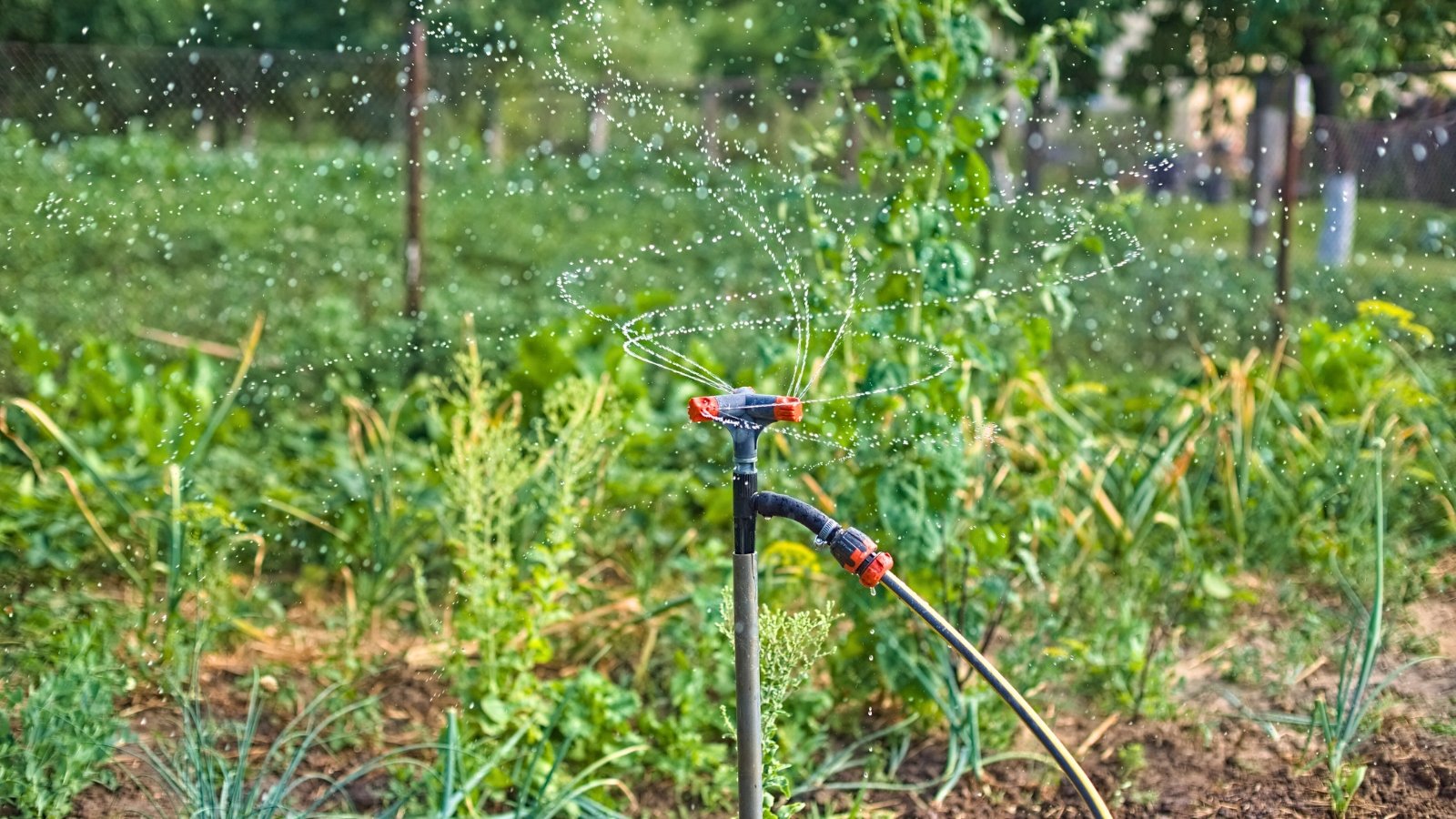

















 English (US) ·
English (US) ·  French (CA) ·
French (CA) ·